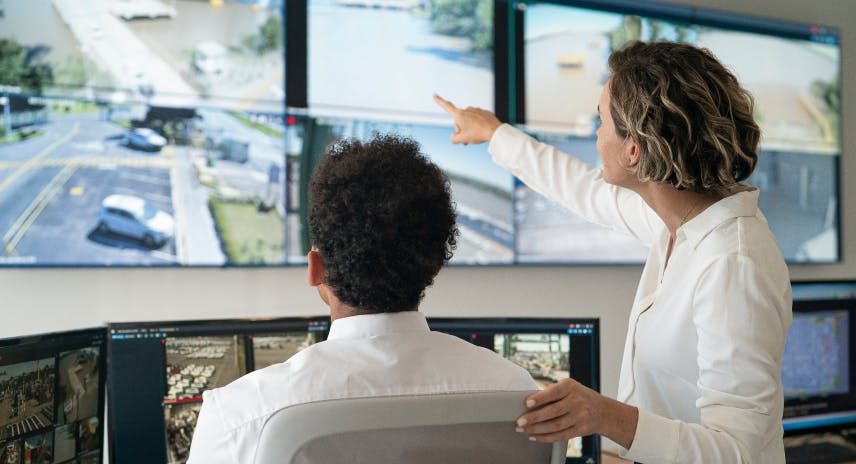
- Artificial Intelligence
Winning the race to reduce false alarms in SOCs: Why Artificial Intelligence makes the cut
Over the years, a lack of shared information or data correlation between systems has been a source of false alarms for Service Operations Centers (SOCs). Typical results included misallocating resources and the potential to miss real threats, sometimes straining the relationship between service providers and customers. By exploring today's technology to improve collaboration and information sharing between different systems, SOCs can enhance their operational capabilities and reduce the number of false alarms.
Advanced, cloud-based artificial intelligence (AI) software has changed the game for SOCs. Using cloud-based analytics, AI, and machine learning can help control centers and SOCs process data more efficiently, enabling them to detect alarm patterns and recommend actions to prevent future false alarms. This approach can lower costs, reduce business disruption, and enhance the effectiveness of a security system.

What is Artificial Intelligence's role in reducing false alarms?
AI video analytics mimics human vision by learning from the mass amounts of video footage it analyzes. By accurately detecting and classifying objects of interest and filtering irrelevant noise, the technology can remove up to 95% of false alarms in video surveillance setups. The most advanced systems allow businesses to define custom criteria for what is a true and false alarm. For example, to spot the difference between a drone and a bird that flies over a restricted business facility and categorize the first as a true alarm.
AI uses machine learning algorithms to analyze large amounts of data to identify patterns, anomalies, and correlations that would be difficult or impossible for humans to detect. It analyzes historical data from various sources, such as environmental sensors, user behavior, and system logs. That way, AI can identify patterns that have led to false alarms in the past.
Once AI has identified these patterns, it can provide recommendations for preventing these false alarms from occurring in the future. For example, AI could recommend changing sensor placement or sensitivity if a sensor consistently triggers false alarms in a particular environment. Over time, the AI system learns from its recommendations and more accurately predicts and prevents false alarms.
AI can also improve the accuracy of alarm verification, confirming that an alarm is genuine before alerting the authorities or taking other actions. AI algorithms can quickly analyze various data sources, such as video feeds or audio recordings, to determine whether an alarm is real or a false positive.
Aside from AI, automation is already utilized in the remote monitoring industry via smart platforms and alarm-handling software. Several functions can be pre-determined, including, but not limited to:
- audio warnings being issued by the system
- contacting keyholders
- engaging the police
- sending fault alert emails
- automated reports sent
All of the above were, at some point, manual tasks. Integrated into automated alarm management platforms like evalink, AI can support operators through its ability to analyze large amounts of data from various security sensors and sites.

The benefits of Artificial Intelligence-powered security solutions
More accurate alarm verification
By using AI to monitor alarm systems, operators can benefit from increased accuracy in identifying actual alarm events. AI algorithms can learn to differentiate between normal and abnormal alarm events and filter out false alarms.
By proactively monitoring the status and performance of all systems, devices, and the responses of SOC operators, a more efficient system can predict and prioritize devices that need repair and highlight any gaps in SOC training programs. This enables SOC operators to focus on real security issues reducing overall risks of failures.
Increased efficiency
AI can help to automate the alarm monitoring process, reducing the need for manual intervention. This automation can help to increase the efficiency of the alarm monitoring center, reducing the time taken to respond to actual alarm events. With AI, operators can benefit from faster response times, reducing the risk of damage or loss.
Improving the ability to focus and allocate time to incoming alarms that need the operator's attention provides immediate value to security businesses. Equipped SOCs have reported "full-time equivalent" gains in productivity within just months of deployment.
Better work experience
Monitoring video camera feeds all day is a demanding job in itself. False alarm reduction software enables them to concentrate on genuine alerts, giving operators a greater feeling of accomplishment, better performance, and higher morale overall.
Cost-effective
False alarms waste personnel time and equipment resources at alarm monitoring centers. AI helps by allowing operators to focus on actual alarm events. Retaining experienced employees reduces recruitment and training costs. False alarm fines are usually charged to the central station, causing a difficult choice for management.
Cloud-based AI software requires no hardware devices at the customer's site, reducing installation costs. AI and machine learning can even recommend actions to reduce false alarms, such as replacing faulty panels or changing the behavior patterns of occupants. These identify building areas with high false alarm activity and risk and can track corrective options to improve operational cost reductions.
Scalability on-demand
AI is highly scalable, meaning it can monitor any volume of data. This scalability makes AI an ideal tool for alarm monitoring centers simultaneously monitoring a few or a thousand sites. By using AI, alarm monitoring centers can easily monitor multiple sites, reducing the need for additional personnel.
With reduced false alarms, trained SOC operators can immediately decrease response times and improve customer service.
Improved customer satisfaction
The thousands of false alarms received daily limit how much time control room operators can spend on genuine activations, and true alarms can be missed. So, reducing the noise of false alerts goes a long way in enhancing customers' security.
False alarms frustrate customers and can undermine their trust in SOCs, which customers rely on for reliable security services. By using AI to reduce false alarms, alarm monitoring centers can improve customer satisfaction by providing a more reliable and efficient service.

More Revenue Opportunities
SOCs can boost income by retaining more customers due to their high-quality services. Fewer false alarms give operators more time, enabling security managers to add customers without hiring more employees or investing in new equipment and facility space.
And as skilled labor becomes more expensive and harder to find, SOCs can look for software to help fill gaps. However, AI-based software is meant to augment, not replace, human operators. Improved operational performance may enable managers to pursue more competitive customer service quality faster.
AI technology to grow and future-proof security businesses
As security professionals begin investing heavily in digital transformation, AI is critical to staying ahead of the curve. AI in any SOC operations system allows for optimizing front and back-end operations to transform operations from reactive to proactive solutions. Most importantly, it helps provide a safer environment for clients and better service delivery. Combining data and artificial intelligence technology accelerates innovation and creates competitive advantages, which SOCs must implement to stay ahead of customers' growing needs or risk missing business opportunities.
evalink + PromiseQ: Filtering up to 95% false alarm
The PromiseQ integration for evalink enhances security operations with a real-time alerting solution that uses deep learning AI technology to perform video analytics – ideal for continuous off-site monitoring.
PromiseQ false alarm reduction software easily integrates with evalink and quickly deploys with no on-premises hardware required. Once a video alarm is triggered on a connected camera, a video is analyzed with algorithms looking for human and vehicle movement before returning genuine alarms. By analyzing what objects are causing motion in a scene, the system learns to deliver relevant alert notifications in line with specific configurations in seconds. Filtering up to 95% of false alarms significantly reduces the chance of SOC operators missing or being delayed in their response to an actual event. The best part? It's integrated into the evalink smart alarm management platform. Check out the evalink marketplace to discover the potential for your business.
Experience the power of AI live with evalink. Get a demo today.


